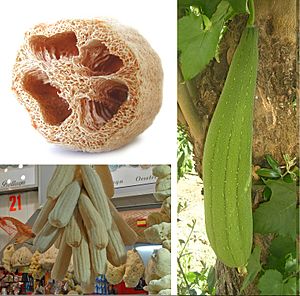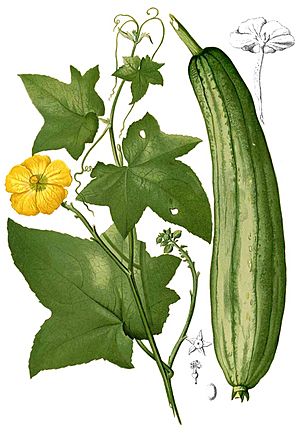Sponge gourd facts for kids
Quick facts for kids Sponge gourd |
|
|---|---|
 |
|
| Egyptian luffa fruit | |
| Scientific classification | |
| Genus: |
Luffa
|
| Species: |
aegyptiaca
|
| Synonyms | |
The Luffa aegyptiaca is a cool plant often called the sponge gourd. People also know it as the Egyptian cucumber or Vietnamese luffa. It's a type of vine that grows every year. This plant is grown for its fruit, which comes from South Asia and Southeast Asia.
Contents
What is a Luffa?
The luffa plant has leaves that look like they have three main parts. These leaves can be quite wide, about 7.5 to 20 centimeters across.
The fruit of the luffa plant is long, usually around 30 centimeters. When it's fully grown, it turns brown. It looks a bit like a large cucumber in its shape and size.
Where Did the Name Come From?
The scientific name for this plant is Luffa aegyptiaca. The word "aegyptiaca" means "from Egypt." This name was given to the plant in the 1500s.
European scientists learned about the plant because it was grown in Egypt. A scientist named Johann Veslingius first wrote about it in 1638. He called it the "Egyptian cucumber" and also introduced the name "Luffa."
How to Grow Luffa
People in Asia have grown luffa for hundreds of years. They use it as a cleaning tool around the house. Today, its natural fibers are popular for scrubbing skin in eco-friendly beauty products.
The plant has bright yellow flowers, so some people grow it just because it looks pretty.
Luffa needs a lot of warmth and water to grow well. But you can also grow Luffa aegyptiaca in places with milder weather. Some studies in North America show that growing luffa could be a good business.
To grow luffa successfully, people often use black plastic sheets on the ground. This helps to warm up the soil. They also start the plants indoors and then move them outside. This helps more seeds sprout and makes the growing season longer.
It's best to grow luffa with a trellis or something similar for support. This helps the vines climb and keeps the fruit off the ground.
What is Luffa Used For?
When the luffa fruit is young, people eat it as a vegetable. It's a common food in tropical parts of Asia.
But when the fruit is fully grown, it becomes very fibrous and you can't eat it. Instead, these mature fruits are used to make scrubbing bath sponges. Because it's used as a sponge, it's also called a dishrag gourd or vegetable-sponge.
It's also known as smooth luffa to tell it apart from another type called ridged luffa (Luffa acutangula). Both types are used for similar things.
You can also cook and eat the young shoots, flowers, and leaves of the luffa plant. The mature seeds can be roasted and eaten too.
An edible oil can be taken out of the seeds. What's left after making the oil can be used to feed animals like rabbits and catfish. It can also be used as a fertilizer for plants.
-
Sponge gourd in a market in Dhaka, Bangladesh.
| Nutritional value per 100 g (3.5 oz) | |
|---|---|
| Energy | 56 kJ (13 kcal) |
|
14.34 g
|
|
| Sugars | 5.17 g |
| Dietary fiber | 2.9 g |
|
0.34 g
|
|
|
Protein
|
0.66 g
|
| Vitamins | Quantity
%DV†
|
| Vitamin A | 260 IU |
| Thiamine (B1) |
4%
0.046 mg |
| Riboflavin (B2) |
4%
0.042 mg |
| Niacin (B3) |
2%
0.26 mg |
| Vitamin B6 |
8%
0.099 mg |
| Folate (B9) |
3%
12 μg |
| Vitamin C |
7%
5.7 mg |
| Vitamin E |
2%
0.24 mg |
| Vitamin K |
2%
1.7 μg |
| Minerals | Quantity
%DV†
|
| Calcium |
1%
9 mg |
| Iron |
3%
0.36 mg |
| Magnesium |
6%
20 mg |
| Phosphorus |
4%
31 mg |
| Potassium |
15%
453 mg |
| Sodium |
1%
21 mg |
| Zinc |
2%
0.17 mg |
|
Link to USDA Database entry
|
|
| †Percentages estimated using US recommendations for adults. | |
Luffa in Ancient Art
In Israel, people have used Luffa aegyptiaca since the time of the Late Roman Empire. Young fruits were eaten, and mature fruits were used as bath sponges.
Interestingly, luffa fruits were shown in art for the first time during the Byzantine era in Israel. You can see them decorated on mosaics in churches and synagogues there.
See also
 In Spanish: Lufa egipcia para niños
In Spanish: Lufa egipcia para niños







